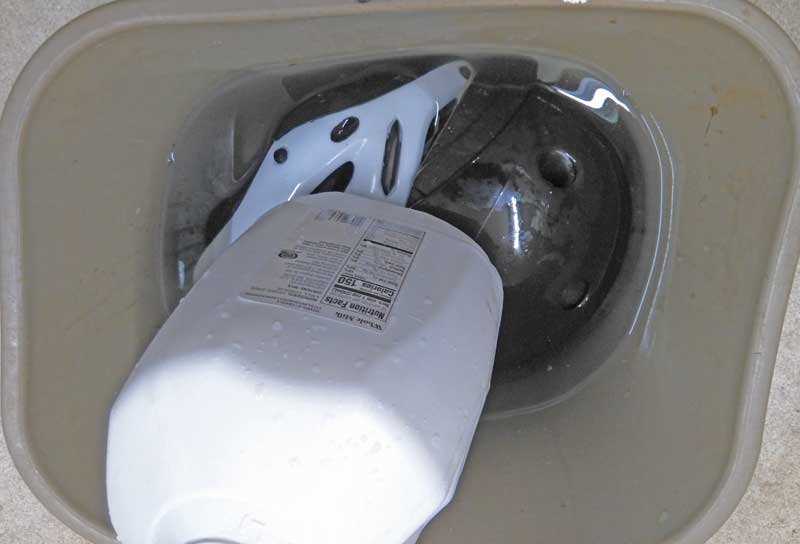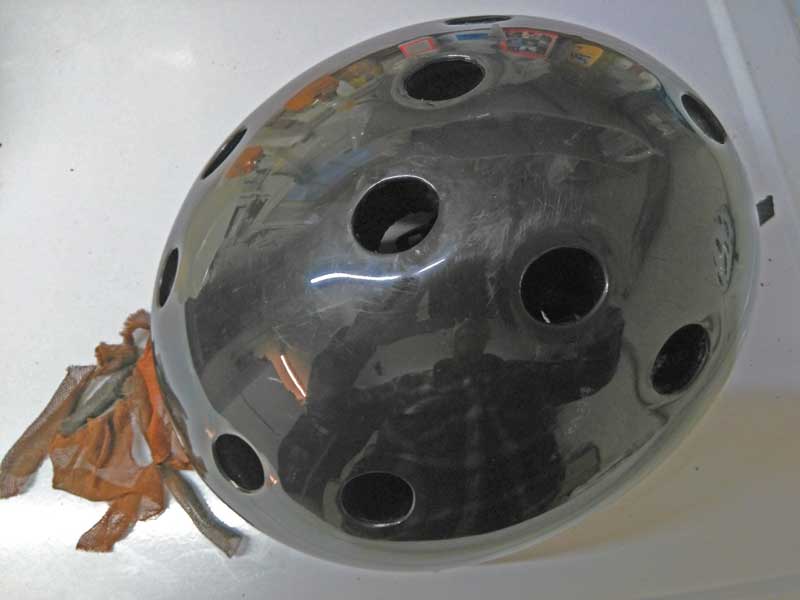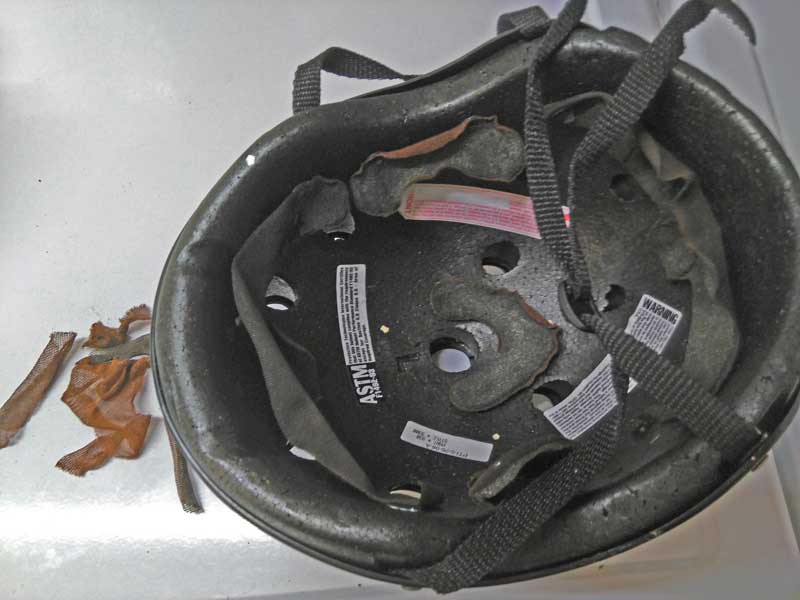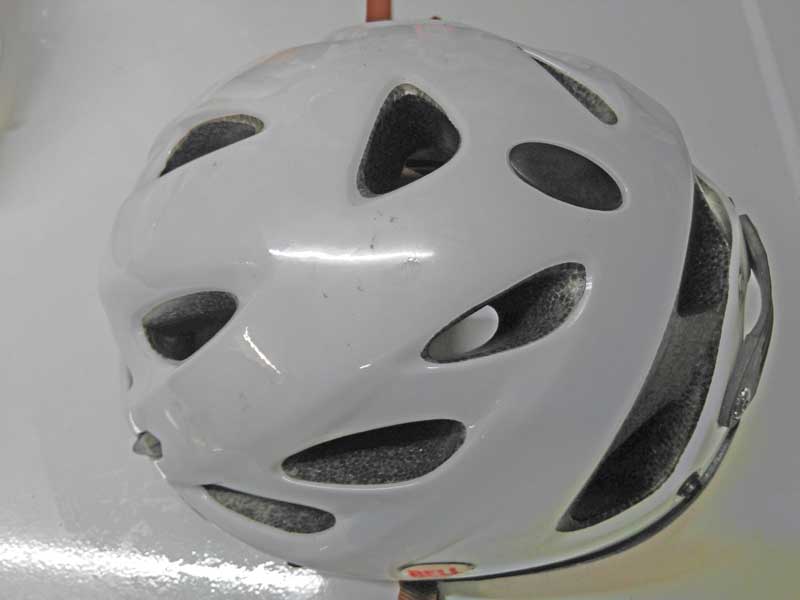Cleaning a Bicycle Helmet
Summary: Clean your bike helmet as recommended by the manufacturer, or just use mild soap and water. Do not put your helmet in a dishwasher. We have COVID-19 advice further down this page for new or used helmets.
Virtually all bicycle helmets come with instructions, and all instructions have directions for cleaning. To clean your helmet you should always follow the manufacturer's instructions. There is no better source for this information, since the manufacturer knows more about the materials and techniques used to make the helmet than anyone else.
If you have no idea where your instructions are, what then?
- You can check the manufacturer's website.
- The usual instructions for cleaning a helmet call for washing it in mild soap and water, rinsing thoroughly, and air drying. We normally use a few drops of dishwashing liquid in a bucket of water and a sponge.
- Some fastidious riders take their helmet into the shower with them after every ride and wash it there.
- Bicycle helmet tests for most standards use one wet sample, immersed for at least four hours before the wet test. So you know that the helmet can be immersed in water and still perform. But do not leave it immersed for long periods of time, since the materials will absorb some water, and that may affect the adhesives used in construction. In addition, foam saturated in water usually gives the head inside a harder landing on flat surfaces.
- Never use solvents or harsh cleaning materials on your helmet, since some of them may attack the foam or the shell and weaken the helmet. We did a test of many commonly used consumer products for helmet damage and found that most of them did not cause performance degradation despite some visible effects.
- Never put your helmet in a washing machine, dryer, microwave or dishwasher to clean it! We have a page on our testing in dishwashers.
- If you are concerned that someone who has worn your helmet may have had head lice, put the helmet in a plastic bag for two weeks until any nits left behind have hatched and died. See the cleaning products below or our page on lice for more solutions.
Do not put your helmet in a dishwasher
We have a page up describing our dishwasher tests that will show you how it will degrade your helmet.Cleaning Products
There are at least three spray products made specifically for helmets.- Progold Helmet Cleaner and Deodorizer comes from a supplier of chain lubes and other bike products. Comes in a spray can. It foams on contact, and you are supposed to wipe it off after a minute, then wipe again with a damp towel. Available in bike shops, where retail is $10 for an 8 oz. can. The cautions: "Use in an area with adequate ventilation. High vapor concentrations can be irritating to the eyes and cause headaches or dizziness...Do not spray near open flames or sparks...Do not expose to heat or store at temperatures above 120 degrees F (49 degrees C)." That means you can't carry it in your car in the summer. It has a pleasantly mild floral/citrus masking scent, with chemical overtones.
- Charles Owen Hat Cleaner and Charles Owen Hat Deodorizer both products come from an equestrian helmet manufacturer and are sold by suppliers of equestrian products. They are for helmets despite the use of "hat" in the name. The cleaner is a foam product. It foams when you spray it on, and you wipe it off after a minute. Both products have good web reviews.
- Bennett Engineering Helmet Fresh If your helmet has gone sour (a problem usually affecting motorcycle or BMX helmets with full liners), Bennett Engineering makes this product to eliminate helmet odor. We have not used it on a sour helmet, but were pleased to find that it has no masking fragrance, just a faintly medicinal or bleach odor. Cycle World said "After kneading the clear fluid into the liner, we left it to air dry. Once it had dried, the helmet didn't smell like new, or even like cheap perfume. In fact, it didn't smell at all." Other reviews on the web support that. Motorcycle stores and websites have it, including Bell (motorcycle) Helmets and Simpson. A four ounce spray bottle runs about $5.
If you want to keep your helmet clean by using a liner, check out the Sanitete disposable liner from France. It probably would interfere with normal fitting pads, but it might be useful for the louse problem when swapping helmets. The cost is just under a US dollar. We have less expensive options on our louse page, including surgical caps, shower caps and painters' caps. The ones used by food service staff work well and are inexpensive.
COVID-19
First, do not put your helmet in a dishwasher or washing machine. We did a study on that and concluded that dishwashers damage bike helmets.The most frequent general advice for cleaning a helmet generally and for eliminating the COVID-19 virus is to wash with soap and water, then dry. CDC had this additional advice about mailed packages that may be relevant on their FAQ page as of March 31, 2020:
"Am I at risk for COVID-19 from a package or products shipping from China?
... In general, because of poor survivability of these coronaviruses on surfaces, there is likely very low risk of spread from products or packaging that are shipped over a period of days or weeks at ambient temperatures. Coronaviruses are generally thought to be spread most often by respiratory droplets. Currently there is no evidence to support transmission of COVID-19 associated with imported goods and there have not been any cases of COVID-19 in the United States associated with imported goods. "
In addition, testing has shown that the virus "was detectable in aerosols for up to three hours, up to four hours on copper, up to 24 hours on cardboard and up to two to three days on plastic and stainless steel." If the helmet is wet the virus may live longer.
We tested the bleach solutions CDC recommends to clean the virus off most surfaces (1/3 cup bleach to 1 gallon of water) for helmet damage. The mix is surprising strong, and just a sip burns the tongue and mouth enough to threaten real damage if you swallowed any. (Our tester spat it out immediately and rinsed.) Just a dip into that mix should kill the virus, but we wanted to set up a worst-case test to make sure it would not damage the helmet. Our test rig was a gray plastic receptacle commonly known as a trash can. Here is a photo of two helmets, black and white, in our test rig:

The helmets are held under the surface but not entirely submerged. We are using fresh heavy duty Clorox Performance Bleach, 7.55 per cent Sodium Hypochlorite. It came from Costco one month earlier. Since labs were closed at the time, we are not able to crash test the helmets after the test as we did for our earlier study of cosmetics, sunscreens and hair products.
The ASTM and CPSC bicycle helmet standards require helmets to perform in impact tests after being immersed in ambient temperature "potable water" for a minimum of four hours. Adding a third of a cup of bleach to the gallon of water is not a radical change in that requirement, although the solution is strong.
You would not want to do this at home, but we immersed the two helmets in the water and bleach solution for 40 hours. That is ten times the length of time they are normally immersed by the test lab. We then washed them off and let them dry for three days. The older helmet was from 1998, and it suffered pad deterioration, with the pads turning to dust, but that is typical of 20 year old helmets anyway. It was otherwise intact and would provide good impact protection.


The newer helmet showed no effects.


Both helmets still had their original labels. Although we are not able to test the straps in a lab at this point, both straps resisted strong pulls and seemed as strong as ever. The buckles worked well and seemed unaffected. The rear stabilizer adjustment on the newer helmet still worked.
We conclude that if you decide to use a water/bleach solution to speed up decontamination of a helmet that may have been exposed to COVID-19 you are not likely to damage the helmet. If you have more time, just putting the helmet on a shelf for more than three days will accomplish the same thing according to the CDC data. That's what we would recommend doing, even with a brand new helmet. The bleach could fade a new helmet's interior, so we would just quarantine it and wash it normally with warm water and mild soap before wearing as you would with any new article of clothing.
There are many other chemicals that can eliminate COVID-19 quickly that we have not tested. The Environmental Protection Agency has a list of chemicals that meet their criteria for use against COVID.
Back to the top
Back to the Home Page